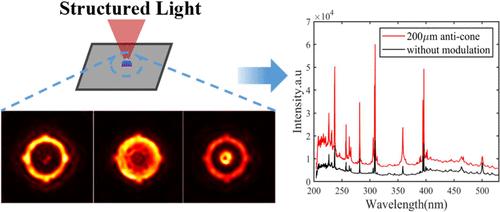利用二维结构光的激光诱导击穿光谱:金属样品光谱信号增强的一个案例
IF 6.7
1区 化学
Q1 CHEMISTRY, ANALYTICAL
引用次数: 0
摘要
激光诱导击穿光谱(LIBS)是一种极具潜力的元素探测技术,但由于探测窗口内等离子体的非理想特性而面临诸多问题。激光在样品表面的能量分布对等离子体性能和光谱发射有重要影响。然而,相关研究仍然有限,缺乏一个良好的自由度(DOF)来系统地探讨其影响。在这项工作中,使用空间光调制器(SLM)产生二维结构光。利用金属样品测试了具有不同横截面面积的各种焦斑图案,从而分离了焦斑结构和横截面面积的影响。采用直径为200 μm的箭头靶和反锥,纯铝样品的线增强系数大于3,纯铜样品的线增强系数约为6。轴承钢样品的信噪比显著提高,Cr、Mn、Si、Cu和Al的检出限(LOD)降低了约6倍。为了更好地理解这种改进背后的机制,测量了时间分辨光谱,并从中计算了电子密度和等离子体温度演变。结果表明,在反锥和箭靶模式下,电子密度增加了50%以上,而等离子体温度变化小于500 K,表明有明显的烧蚀增强。等离子体自发射的快速图像证明了激光能量分布对等离子体羽流形态的影响。反锥型和矢靶型的等离子体核心经过膨胀和冷却后更加致密,减少了等离子体羽流与周围空气的混合。因此,SLM首次应用于LIBS,可以合理设计和生成微米分辨率的焦斑结构,并具有高自由度。实现了显著的频谱信号增强和更低的LOD。这项研究为等离子体特性中焦模式的作用提供了新的见解,表明了使用结构光控制等离子体的未来可能性。本文章由计算机程序翻译,如有差异,请以英文原文为准。

Laser-Induced Breakdown Spectroscopy Using 2D Structured Light: A Case of Spectral Signal Enhancement on Metal Samples
Laser-induced breakdown spectroscopy (LIBS), an elemental detection technique with great potential, faces many problems mainly caused by the nonideal plasma properties in the detection window. The 2D laser energy distribution on the sample surface has a crucial impact on the plasma properties and spectral emission. However, relevant studies are still limited, lacking a good degree of freedom (DOF) to systematically explore its influence. In this work, 2D structured light was generated by using a spatial light modulator (SLM). Various focal patterns with different cross-section areas were tested using metal samples so that the effects of the focal spot structure and cross-section area could be separated. The arrow-target and anticone of 200 μm diameter resulted in a line enhancement factor of more than 3 for a pure aluminum sample and a factor of about 6 for the pure copper sample over that without beam modulation. A significant improvement in the signal-to-noise ratio and a reduction in the limit of detection (LOD) of Cr, Mn, Si, Cu, and Al by a factor of about 6 were also achieved with the bearing steel sample. To better understand the mechanism behind such improvements, time-resolved spectra were measured, from which the electron density and plasma temperature evolution were calculated. The results showed that with anticone and arrow-target patterns, the electron density was increased by more than 50%, while the plasma temperature varied less than 500 K, suggesting an evident ablation enhancement. The fast images of plasma self-emission proved that the laser energy distribution substantially influenced the morphology of the plasma plume. The plasma cores produced by the anticone and arrow-target focal patterns were more compact after the expansion and cooling process, which could reduce the mixing of plasma plumes and ambient air. Thus, with the first application of SLM in LIBS, focal spot structures of micrometer resolution could be rationally designed and generated with a high DOF. Substantial spectral signal enhancement and a much lower LOD were achieved. This study provides new insights into the role of focal patterns in plasma properties, suggesting the future possibility of plasma control using structured light.
求助全文
通过发布文献求助,成功后即可免费获取论文全文。
去求助
来源期刊

Analytical Chemistry
化学-分析化学
CiteScore
12.10
自引率
12.20%
发文量
1949
审稿时长
1.4 months
期刊介绍:
Analytical Chemistry, a peer-reviewed research journal, focuses on disseminating new and original knowledge across all branches of analytical chemistry. Fundamental articles may explore general principles of chemical measurement science and need not directly address existing or potential analytical methodology. They can be entirely theoretical or report experimental results. Contributions may cover various phases of analytical operations, including sampling, bioanalysis, electrochemistry, mass spectrometry, microscale and nanoscale systems, environmental analysis, separations, spectroscopy, chemical reactions and selectivity, instrumentation, imaging, surface analysis, and data processing. Papers discussing known analytical methods should present a significant, original application of the method, a notable improvement, or results on an important analyte.
 求助内容:
求助内容: 应助结果提醒方式:
应助结果提醒方式:


